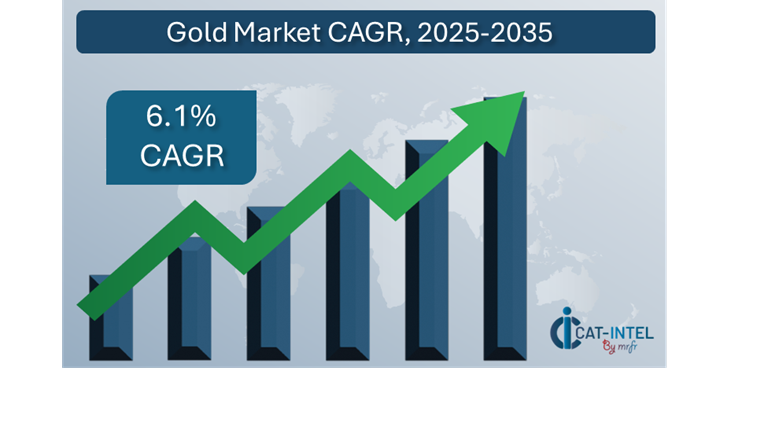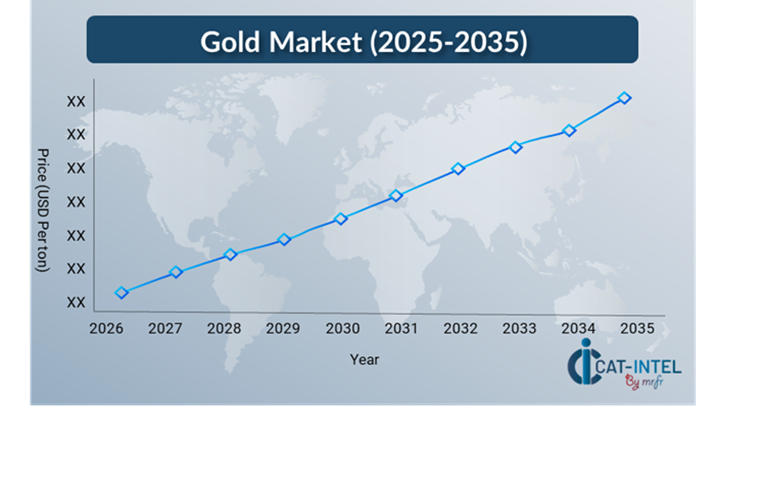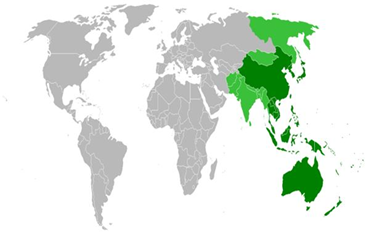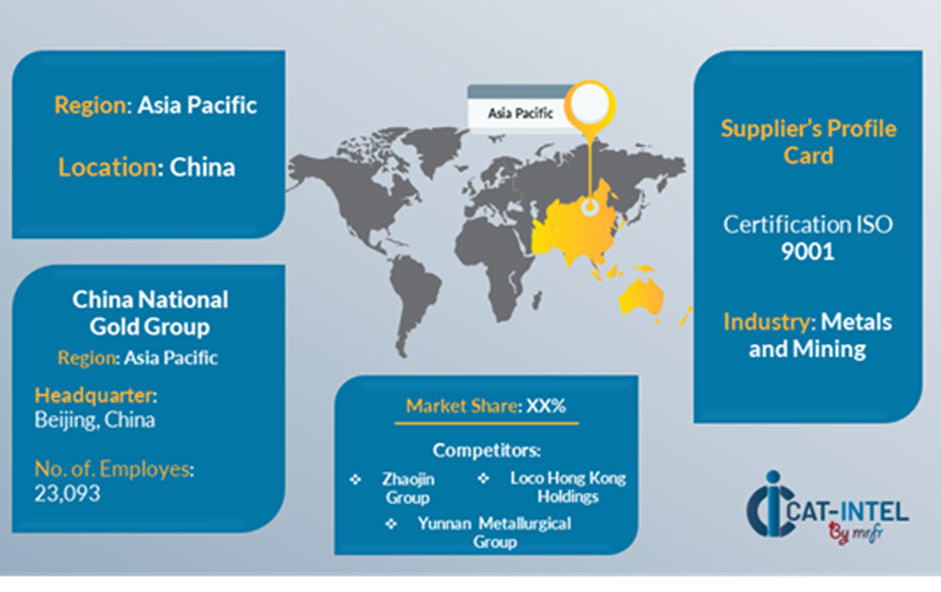Summary Overview
Gold Market Overview:
The worldwide gold market is steadily expanding, propelled by demand from a variety of sectors including investment, jewellery, technology, and central institutions. This market is varied and includes actual gold, gold-backed financial products, and digital gold solutions. Our paper analyses procurement trends in depth, with an emphasis on cost optimization tactics and the use of new digital tools to improve gold trading and operational efficiency.
Key future problems in gold procurement include managing price fluctuations, assuring scalability, maintaining security standards, and integrating new technology into existing supply chains. Digital trading platforms and strategic sourcing are crucial to optimizing gold procurement and maintaining long-term market competitiveness. As global demand rises, organizations are leveraging market information to boost operational efficiency, manage risks, and fulfil growing consumer needs.
Market Size: The global gold market is projected to reach USD 483.42 billion by 2035, growing at a CAGR of approximately 6.1% from 2025 to 203

Growth Rate: 6.1
Sector Contributions: Growth in the market is driven by:-
Manufacturing and Supply Chain Optimization: There is a growing need for real-time data and process integration to streamline gold supply networks and improve operational efficiency.
-
Increased Use of Technology: In gold retail has led to improved inventory management, demand forecasting, and customer involvement through digital platforms.
-
Technological Transformation: Advancements in AI and machine learning are improving gold trading platforms by enabling predictive analytics, automation, and better decision-making.
-
Innovations: The advent of modular solutions enables firms to pick and integrate only the features they need, making gold trading systems more efficient and cost-effective.
-
Investment Initiatives: Companies are investing in cloud-based solutions to cut infrastructure costs and improve accessibility, creating a more flexible environment for global gold market participants.
-
Regional Insights: Asia Pacific and North America continue to be significant participants in the gold market, with strong digital infrastructure driving adoption of cloud-based and digital gold platforms.
Key Trends and Sustainability Outlook:
-
Cloud Integration: Increasing the use of cloud-based solutions for scalability, cost efficiency, and real-time gold market data.
-
Advanced Features: The integration of AI, IoT, and blockchain technology improves decision-making, automates trading processes, and increases transparency in gold transactions.
-
Focus on Sustainability: Digital tools in the gold market allow for better tracking of gold sourcing, assuring ethical procedures and compliance with sustainability standards.
-
Customization Trends: There is an increasing demand for industry-specific tools targeted to areas such as jewellery, investment, and technology, which is leading to increasingly specialized gold trading systems.
-
Data-Driven Insights: The incorporation of modern analytics technologies allows gold market participants to forecast demand variations, optimize inventories, and monitor important market performance parameters.
Growth Drivers:
-
Digital Transformation: Aims to boost efficiency, streamline processes, and increase market access.
-
Demand for Process Automation: A greater dependence on automation to perform repetitive trading and reporting duties, minimizing manual intervention and increasing market efficiency.
-
Scalability Requirements: Gold market participants are implementing scalable systems that adapt to changing market dynamics, ensuring easy interaction with new technologies and data sources.
-
Regulatory Compliance: Digital solutions are critical for ensuring compliance with worldwide rules governing gold sourcing, trade, and reporting standards.
-
Globalization: Increasing demand for solutions that facilitate worldwide gold transactions, including multi-currency and multi-language, and international compliance features, as the market becomes increasingly interconnected.
Overview of Market Intelligence Services for the Gold Market:
Recent evaluations of the gold market have highlighted important issues, such as shifting pricing and the difficulty of obtaining dependable, ethical suppliers. Market intelligence studies give actionable information that help businesses identify cost-saving possibilities, optimize supplier relationships, and improve the whole procurement process. These insights assist firms in navigating the complexity of procuring gold, ensuring compliance with industry standards, and maintaining high-quality operational processes while successfully controlling costs.
Procurement Intelligence for Gold: Category Management and Strategic Sourcing
To remain competitive in the gold market, businesses are fine-tuning their procurement strategies through extensive expenditure monitoring and supplier performance tracking. Effective category management and strategic sourcing are critical for lowering procurement costs while ensuring a steady supply of high-quality gold. Businesses can use actionable market intelligence to improve their procurement strategies, negotiate advantageous terms, and maximize the sourcing of gold and related materials, ensuring long-term success in an evolving market.

Pricing Outlook for Gold: Spend Analysis
The pricing outlook for the gold market is projected to remain moderately volatile, with variations affected by a variety of variables. Advancements in extraction technology, increased demand for digital gold goods, regional pricing disparities, and a growing emphasis on ethical sourcing are all key drivers. Furthermore, the growing use of AI for market forecasting and the demand for sustainable, traceable gold sources are putting upward pressure on gold prices.

Graph shows general upward trend pricing for Gold and growing demand. However, there may be fluctuations influenced by economic conditions, technological advancements, and competitive dynamic.
Efforts to streamline procurement processes, improve supplier management, and investigate innovative sourcing methods are critical for cost reduction. Using digital tools for market monitoring, price forecasting analytics, and streamlining contract management can all help to increase cost efficiency in gold procurement.
Partnering with reputable gold suppliers, negotiating long-term contracts, and exploring flexible pricing structures will be critical tactics for effectively managing gold procurement costs. Regardless of these obstacles, concentrating on sustainability, establishing stable supply chains, and leveraging technology for market insights will be crucial to sustaining cost-effectiveness and operational excellence in the gold market.
Cost Breakdown for Gold: Total Cost of Ownership (TCO) and Cost-Saving Opportunities

- Gold Purchase Price: (50%)
-
Description: The biggest cost component is the price of gold, which fluctuates according to global supply and demand, geopolitical events, and market speculation.
-
Trend: Gold prices are impacted by a variety of factors, including inflationary pressures, global economic conditions, and monetary policy. During times of economic uncertainty, gold prices generally rise because it is seen as a safe-haven asset.
- Transportation & Logistics: (XX%)
- Refining and Processing: (XX%)
- Storage and Insurance: (XX%)
Cost-Saving Opportunities: Negotiation Levers and Purchasing Negotiation Strategies
In the gold market, streamlining procurement processes and using strategic bargaining strategies can result in significant cost savings and improved operational efficiency. Long-term relationships with reputable gold suppliers, particularly those who provide sustainable sourcing and traceable gold, can result in more attractive price structures and terms, such as volume-based discounts and bundled service offers. Flexible pricing structures and multi-year contracts allow you to acquire better prices and hedge against price volatility over time.
Collaborating with gold suppliers who prioritize innovation, sustainability, and scalability provides additional benefits, such as access to advanced market insights, predictive analytics, and traceable sourcing systems, resulting in lower long-term procurement costs. Implementing digital procurement technologies like supply chain management systems and market trend analytics increases transparency, reduces overstocking, and optimizes gold sourcing and inventory management. Diversifying vendor alternatives and implementing multi-vendor methods can assist reduce reliance on a single supplier, alleviate risks like as supply chain disruptions, and increase bargaining power, resulting in more resilient and cost-effective gold procurement strategies in the long run.
Supply and Demand Overview for Gold: Demand-Supply Dynamics and Buyer Intelligence for Effective Supplier Relationship Management (SRM)
The gold market is steadily expanding, propelled by factors such as investment demand, jewellery consumption, and more technological integration in gold trade and sourcing. Supply and demand dynamics are influenced by technological breakthroughs, shifting consumer preferences, and global economic conditions.
Demand Factors:
-
Investment Demand: As economic concerns worsen, there is a growing interest in gold as a safe-haven investment, fuelling demand throughout financial markets.
-
Technological Integration: As digital gold trading platforms and blockchain-based solutions become more prevalent, the demand for secure and efficient gold transaction systems grows.
-
Industry-certain Requirements: Certain industries, such as jewelry and electronics, require certain types of gold with distinct purity and sourcing requirements.
-
Sustainability Concerns: Consumer demand for ethically sourced and environmentally responsible gold is changing how gold items are sourced and traded.
Supply Factors:
-
Technological Advancements: Include innovations in gold extraction and refining technology, as well as blockchain for supply chain transparency, which are increasing gold availability and supplier competition.
-
Vendor Ecosystem: With an increasing number of gold suppliers, including both large-scale miners and smaller, specialized traders, buyers have a wider range of possibilities.
-
Global Economic Factors: Currency changes, geopolitical events, and labor costs in gold producing locations have a substantial impact on gold prices and market stability.
-
Sustainability and Traceability: Rising demand for traceable and sustainably sourced gold is resulting in more sustainable mining and supplier practices, which influences market supply and prices.
Regional Demand-Supply Outlook: Gold

The Image shows growing demand for Gold in both Asia Pacific and North America, with potential price increases and increased Competition.
Asia Pacific: Dominance in the Gold Market
Asia Pacific, particularly China, is a dominant force in the global gold market due to several key factors:
-
High demand for gold in Jewellery: Gold is seen as a symbol of riches, status, and tradition, which accounts for its great demand at weddings, festivals, and cultural gatherings.
-
Gold as a Safe-Haven Investment: Investors in the region, notably in China and India, see gold as a safe-haven asset during times of economic uncertainty or inflation.
-
Rapid Economic Growth and Rising Affluence: As Asia-Pacific economies expand, the middle class grows swiftly, increasing disposable income and the ability to buy gold.
-
Gold Importing and Refining Hub: Countries such as India, China, and Hong Kong are important importers of gold, while Singapore and Switzerland have great refining capabilities, assuring the region's central role in global gold supply chain.
-
Gold Mining and Production: Countries with enormous gold reserves and advanced mining technologies not only supply the region but also have a big impact on global gold production and prices.

Asia Pacific Remains a key hub Gold Price Drivers Innovation and Growth
Supplier Landscape: Supplier Negotiations and Strategies
The gold market's supplier landscape is equally diversified and competitive, with both large-scale global firms and smaller, specialized suppliers shaping industry dynamics. These vendors have a significant impact on gold pricing, sourcing procedures, product quality, and supply chain transparency. Established mining businesses dominate the market, large global operations, while smaller, niche suppliers concentrate on ethically sourced gold, sustainable mining processes, and specialized supplies for industries such as jewelry and electronics.
The gold supplier ecosystem encompasses significant mining regions, including major global giants in China, Canada, Australia, and South Africa, as well as smaller, creative suppliers in emerging markets that provide eco-friendly and traceable gold. As businesses and consumers prioritize sustainability and ethical sourcing, gold suppliers are implementing cutting-edge technology like blockchain for traceability and AI-powered analytics to improve efficiency and reduce environmental impact. These suppliers are also offering more flexible pricing methods and collaborating with enterprises to fulfill the changing market need for responsibly sourced gold.
Key Suppliers in the Gold market include:
- China National Gold Group
- Barrick Gold Corporation
- Newmont Corporation
- AngloGold Ashant
- Gold Fields Limited
- Polyus Gold
- Kinross Gold
- Royal Gold, Inc.
- Shaanxi Coal and Chemical
- Freeport-McMoRan Inc.

Key Developments Procurement Category Significant Development:
Significant Development |
Description |
Market Growth |
The gold market is expanding significantly, driven by rising investment demand, increased consumption in areas such as jewelry and electronics, and a growing emphasis on sustainability. Gold is in high demand in emerging nations, particularly as a hedge against economic uncertainty and a store of value. |
Cloud Adoption |
The gold market's transition to digital platforms and online trading is accelerating, with cloud-based solutions gaining favor due to their scalability, cost-efficiency, and capacity to support remote transactions. |
Product Innovation |
To improve transparency and security, gold market players are incorporating cutting-edge technologies such as AI-driven analytics, blockchain for monitoring gold provenance, and real-time pricing systems. |
Technological Advancements |
AI-powered market forecasting tools, IoT sensors for supply chain tracking, and automation in gold processing and refining are all helping to improve gold market efficiency. These innovations improve predictive insights and enable more precise inventory management.
|
Global Trade Dynamics |
Global trade policy changes, currency volatility, and geopolitical conflicts all have an impact on gold market supply and demand. Regulatory changes and international compliance standards are changing how gold is sold globally, particularly as governments strive for greater openness in sourcing. |
Customization Trends |
Jewelry design, investment-grade gold items, and sustainable gold sourcing options are all experiencing an increase in demand. Buyers and investors desire flexibility and specialized products, spurring advances in packaging, sourcing methods, and market access for different customer segments. |
Gold Attribute/Metric |
Details |
Market Sizing |
The global gold market is projected to reach USD 483.42 billion by 2035, growing at a CAGR of approximately 6.1% from 2025 to 2035. |
Gold Technology Adoption Rate |
The gold market is seeing a surge in the use of digital tools, with an estimated 60-65% of gold trading and investing businesses using digital platforms for real-time tracking, analytics, and transactions.
|
Top Gold Industry Strategies for 2025 |
AI and Machine Learning Integration: Using AI to forecast prices, manage risks, and make investment decisions. Ensure secure and traceable gold sourcing, especially in response to rising demand for ethically sourced gold. |
Gold Process Automation |
Approximately 50-55% of gold market transactions are automated, mostly for inventory management, pricing modifications, and regulatory compliance. Trading platforms and processing systems are progressively being automated, which helps to eliminate human error. |
Gold Process Challenges |
Gold prices are volatile, making long-term planning and forecasting challenging for businesses and investors. Ethical sourcing and traceability from mine to market represent considerable operational obstacles.
|
Key Suppliers |
Leading suppliers include China National Gold Group, Barrick Gold Corporation and Newmont Corporation. These firms dominate the gold mining sector, providing a diverse range of mining and processing services worldwide.
|
Key Regions Covered |
Prominent regions for gold market adoption and commerce are Asia Pacific and North America There is strong demand for gold in both traditional markets (jewellery and investment) and developing industries for technology integrations.
|
Market Drivers and Trends |
The transition to digital trading platforms, AI-powered price forecasting, and blockchain for supply chain transparency. Consumers and regulators are driving an increase in demand for ethically sourced and ecologically responsible gold. Increased use of artificial intelligence, IoT, and blockchain to improve the transparency, efficiency, and traceability of gold transactions and supply chains.
|

